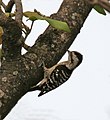Great spotted woodpeckers
| Great spotted woodpeckers | ||||||||||
|---|---|---|---|---|---|---|---|---|---|---|

great spotted woodpecker |
||||||||||
| Systematics | ||||||||||
|
||||||||||
| Scientific name | ||||||||||
| Dendrocopos | ||||||||||
| Koch , 1816 |

The great spotted woodpeckers ( Dendrocopos ) form a genus of birds from the subfamily real woodpeckers within the woodpeckers (Picidae). Depending on the systematic view, 4 to 5 species are native to Central Europe.
description
Great spotted woodpeckers are small to medium-sized, typical woodpeckers with a physique that is closely adapted to life on tree trunks. The beak is large, straight and pointed; the upper beak is longer than the lower beak. The outer (fourth) toe can be put back when climbing, and the tail is designed as a support tail. All species of the genus are colored in a strong contrasting black and white and mostly show red or yellow markings on the head and sometimes also on other body regions.
Way of life
All species of the genus are closely tied to trees and therefore predominantly forest dwellers. Most Central European species also inhabit parks and gardens with old trees. Food is sought on the trunk, on branches and in the treetops, where wood and bark are chopped up or peeled off with the powerful beak. In addition to mainly wood-dwelling insects such as beetle larvae and ants, various fruits and nuts are also part of the food spectrum. The breeding cave is usually created in dead trees or parts of dead trees, the eggs are pure white.
Systematics
The great spotted woodpeckers were first described as a genus in 1816 by Carl Ludwig Koch in his System of Baierische Zoologie in the volume Die Säugethiere und Vögel Bairens .
Since one of the species of this genus is also called great spotted woodpecker , there is often a lack of clarity in German-language literature as to whether the use of the term great spotted woodpecker refers to the genus Dendrocopos or the species Dendrocopos major . The alternative German name "Großer Buntspecht" is therefore preferred by some ornithologists for the species; accordingly, the names "Mitteler Buntspecht" and "Kleiner Buntspecht" are used for medium spotted woodpecker and small woodpecker .
The scope and naming of the genus is still controversial today, the name Picoides was often used for the genus ; of the European species, only the three-toed woodpecker is currently assigned to this genus .
The genus Dendrocopos ( ancient Greek δένδρον dendron 'tree' and κόπος kopos 'striking', 'work') consists of 20 species according to ITIS. These are native to Europe:
- Little Woodpecker ( Dendrocopos minor )
- Middle Woodpecker ( Dendrocopos medius )
- Great Spotted Woodpecker ( Dendrocopos major )
- White-backed woodpecker ( Dendrocopos leucotos )
- Blood woodpecker ( Dendrocopos syriacus )
Not native to Europe:
- Tamarisk woodpecker ( Dendrocopos assimilis )
- Striped- breasted woodpecker ( Dendrocopos atratus )
- Brown end Specht ( Dendrocopos auriceps )
- Gray-headed woodpecker ( Dendrocopos canicapillus )
- Red-breasted woodpecker ( Dendrocopos cathpharius )
- Darjeeling woodpecker ( Dendrocopos darjellensis )
- Arabian woodpecker ( Dendrocopos dorae )
- Himalayan Woodpecker ( Dendrocopos himalayensis )
- Kizukispecht ( Dendrocopos kizuki )
- White-winged woodpecker ( Dendrocopos leucopterus )
- Isabel Woodpecker ( Dendrocopos macei )
- Yellow-crowned woodpecker ( Dendrocopos mahrattensis ) now Leiopicus mahrattensis
- Temminck woodpecker ( Dendrocopos temminckii )
- Scopoli woodpecker ( Dendrocopos maculatus )
- Brown-headed woodpecker ( Dendrocopos moluccensis )
The small great spotted woodpecker Dendrocopos nanus , native to India and Sri Lanka , is currently considered a subspecies of Dendrocopos moluccensis ( Dendrocopos moluccensis nanus ).
Picture gallery
swell
Individual evidence
literature
- Urs N. Glutz von Blotzheim and Kurt M. Bauer: Handbook of the birds of Central Europe. Volume 9: Columbiformes - Piciformes. 2nd ed.; Aula-Verlag, Wiesbaden 1994, pp. 989-990.









